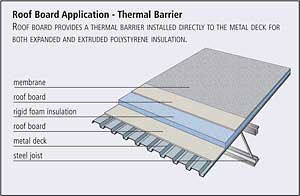Low-Slope Commercial Roofing
To minimize adhesive use, the surface must be dense enough to hold the adhesive out. Boards also must resist moderate levels of moisture without degradation, and surface bonding layers must not delaminate from the core (delamination reduces the bond strength). In addition, the cover board must provide maximum fire protection at virtually any insulation thickness and roof slope.
More recent testing of roof assemblies for resistance to foot traffic and hail provides further evidence of the qualities cover boards can bring to high-quality roof assemblies. FM Global test protocols for hail resistance and ASTM (American Society for Testing and Materials) standards for impact and puncture resistance quantify the performance capabilities of these dense underlayments.
|
||||||||||||||
The Future
Cover boards will continue to play a vital role as a key component within the roof assembly. While some proposed roofing systems would eliminate the cover board, the result would compromise overall system performance levels.
The new generation of cover boards and enhancements to existing materials will make cover boards more critical, especially in more hostile environments. Similarly, fast-track construction creates numerous potentials for trapped water or residual moisture within substrate materials, including newly poured concrete and wet wood framing.
Residual moisture is a fact of construction that affects the installed, in-service materials. Consequently, cover boards become the "last stop" at the roof plane, holding residual moisture just below the roof membrane. Trapped moisture, in vapor form, passes very slowly through most roof membranes. Detail and material changes can be made to accelerate this moisture migration, but the cover board must be capable of performing during such prolonged periods of moisture without a significant loss of performance.
Furthermore, the presence of moisture must not result in the proliferation of mold within the roof assembly and the potential to cause further problems should the mold spores migrate to the building's interior. This issue is being monitored closely by building owners, tenants and insurers alike.
The requirements for greater wind uplift performance with use of low-VOC (volatile organic compounds) adhesives, the potential for reducing asphalt applications due to possible health risks and the reduction in use of torch installations to minimize the risk of fire will all require further advancements in cover board technology. Roof system manufacturers, in conjunction with fastener, adhesive, insulation and cover board manufacturers, must meet the demands for higher performance levels within a changing market.










